B2B Demand Generation: What It Is, Why It Matters & Strategy
Have you heard that 80% of leads never translate into sales?
It’s weird to hear this fact, considering how much money companies pour into marketing campaigns to generate leads. However, InvespCRO is uncompromising about this statement – only 20% of prospects become paying customers.
What’s the reason? Does it mean lead generation is not necessary?
On the contrary – it is crucial for your business. However, you should not focus solely on generating leads but more on forming meaningful relationships with potential buyers. And that’s where demand generation enters the scene.
Not sure what we’re talking about?
Continue reading to learn all about B2B demand generation and what it takes to build a working strategy.
What is B2B Demand Generation?
B2B demand generation is a marketing strategy that focuses on targeting qualified leads by educating them, addressing their pain points, and offering solutions through your product or service.
Demand generation requires a joint effort from multiple business teams to attract more leads and make them interested in becoming paying customers. Oftentimes, you can see the marketing, sales team, and product development departments working together on demand generation processes.
As a multifaceted approach, demand gen involves many digital marketing strategies to bring more prospects to business:
- Email marketing
- Brand messaging
- Inbound marketing
- Content marketing
- Marketing automation
- Social media marketing
- Influencer collaborations
- Account-based marketing (ABM)
- Outreach via LinkedIn and other networks to target accounts of decision-makers
Out of all these tactics, 79% of marketers find email marketing the most effective for demand generation. However, you can’t deny that, in many cases, you need to employ several strategies to achieve the desired outcome.
Is a demand generation strategy difficult to execute?
It can be. Imagine a 7K-piece jigsaw puzzle – you will hardly put it together yourself fast without any assistance. That’s why a B2B demand generation strategy is all about collaboration and multi-team effort.
Demand Generation vs. Lead Generation
Alright, now you have a general idea about demand generation. However, we also mentioned that it is involved in generating prospects, which is also a task for lead generation.
So, are demand and lead generation the same thing? Or are they two different strategies?
This graph by Viral Loops provides great explanation:
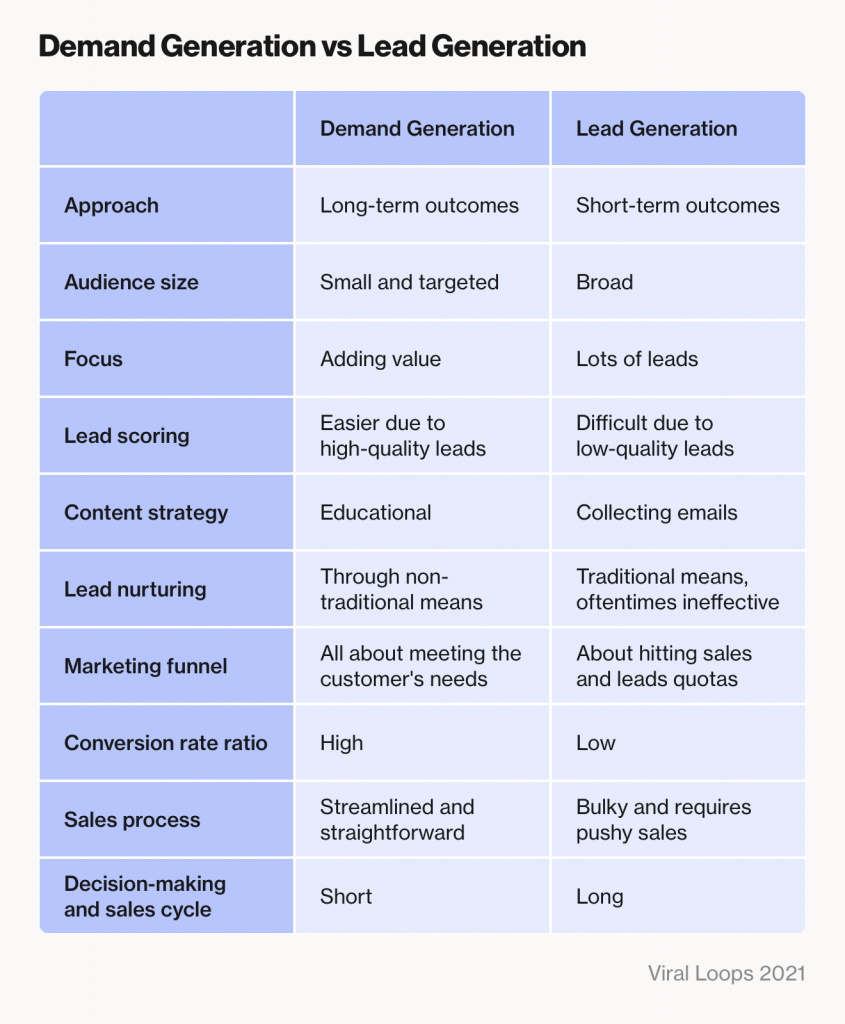
Now, let’s consider both marketing strategies and their characteristics separately.
Demand generation
Demand generation is a process focused on converting strangers into prospects. However, as we pointed out in the definition earlier, it mostly deals with qualified leads, so it follows lead generation and finds itself at the beginning of the buyer’s journey.
We can single out the following features specific to demand generation campaigns:
- The main focus is on providing value, not selling the product.
- It deals with a lower volume of leads, but their quality is higher because they have already been qualified.
- Lead scoring is faster and easier.
- Demand generation deals with a smaller audience.
- Demand gen strategies focus on solving the prospect’s pain points.
- Conversion rates are usually higher.
- The sales process is more straightforward.
Since demand generation marketing focuses on catering to a potential customer’s needs, it takes them less time to make a purchase decision – they already have all the necessary information to do that. Also, we should emphasize that demand gen tactics are long-term oriented.
Lead generation
We already wrote a guide on B2B lead generation, but let’s repeat what it is once again.
Lead generation is a marketing strategy that deals with converting prospects into qualified leads. Its main task is to capture and stimulate a person’s interest in a product or service.
As we already mentioned, lead gen precedes demand generation and is a more short-term strategy. Other characteristic features of lead generation include:
- Focus on a broader audience.
- Leads need scoring and qualification.
- Lead generation deals with a high volume of leads.
- Lead quality is lower.
- Lead generation focuses on collecting contact information from prospects rather than educating them.
- The main goal is to collect as many leads as possible without paying too much attention to their needs.
- Conversion rates are lower.
In other words, this strategy focuses more on sales pitches than providing value. So, with lead generation only, the possibility of closing the prospect is lower.
Then, should we right off lead generation completely?
Of course, not. Otherwise, where will you get enough prospect emails for demand generation? On the other hand, if you focus solely on bringing more leads, you will hardly close enough sales. Creating demand equals creating value.
So, to conclude:
- Lead generation is about grabbing the prospect’s attention.
- Demand generation focuses on targeted marketing to generate further interest.
What Are the Benefits of B2B Demand Generation Strategy
Now you know that continuously generating demand for your product or service is a necessary step towards better sales and more brand awareness. These are the supposed final results of a properly built B2B demand generation strategy.
But which benefits will you get along the way?
Let’s figure out the answer.
Benefit #1: High-quality and qualified leads
As we’ve figured out, demand generation brings prospects of better quality than lead generation alone. The reason is simple – it is the best way to implement awareness. Yet, only 2% of businesses pay enough attention to that.
Here’s how a properly executed demand generation strategy can secure more high-quality leads.
- Stage #1. All your marketing efforts initially go to informing the leads about the ways you can help them. You introduce your brand and your product, they get a chance to know you better, and that’s how you build trust.
- Stage #2. You keep addressing the issues your prospects want to resolve while also highlighting the main perks of your products. As a result, they become more educated and know your brand enough to compare you with similar businesses.
- Stage #3. It’s time for thought leadership. Your task is to provide content and free resources to make the prospect even more informed. You can collaborate with influencers to improve your image.
After such an elaborate process, the lead gains quality points. Such prospects know enough about you to make a more informed decision, so your marketing team can certainly hand them over to a salesperson with a greater probability that they are ready to convert.
Benefit #2: Lower acquisition cost
Earlier, companies invested in outbound and inbound lead generation, thinking it’s sufficient to drive enough sales. However, the average consumer’s attitude has changed over time.
Now, you will hardly find a consumer who doesn’t google a business before buying from it. Most people would also take their time, follow the brand’s activity, and then make a purchase decision.
Such a change of an average consumer’s heart led to higher customer acquisition costs (CAC). Take a look at this graph by Profitwell – it illustrates this shift very well:

To give a bit more context, B2B CAC is about 60% higher than it was five years ago. This is a considerable increase, which also proves that customer acquisition is now more expensive.
What’s the role of demand generation here?
The answer is simple – the goal of this strategy is educating to retain. If you go back to the stages we described in the previous section, you will notice that the success of the lead-to-customer journey depends on how persistent you’re about keeping them informed.
In other words, while lead generation strives to just get a prospect’s contact details, a well-built B2B demand generation strategy will focus all its means on retaining this prospect up until they are warm enough to buy.
Benefit #3: Increased retention
Since we started talking about demand generation helping retain customers, that’s the next benefit worth discussing.
The whole idea of demand gen is to maintain contact with a prospect, and a purchase decision in your favor doesn’t mean that the strategy is no longer applicable. Since your product or service keeps evolving, so should your relationships with the buyers.
The point is to keep a client interested in purchasing more by showing your growing value. For instance, it could be a free tool in addition to the solution they’ve already bought from you.
Consider HubSpot’s Make My Persona generator:
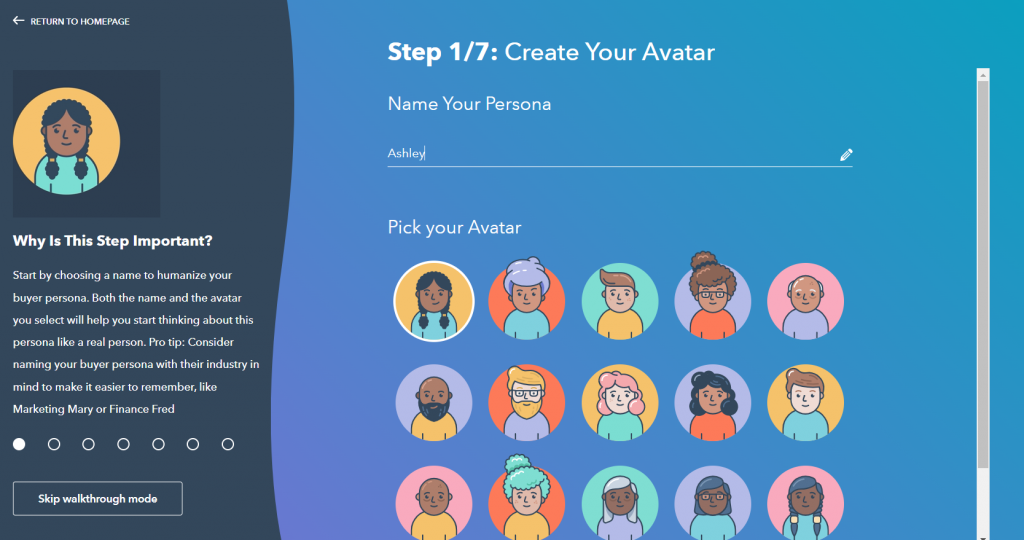
The goal of this feature is twofold. On the one hand, it complements the already existing HubSpot’s marketing toolkit, keeping the existing clients from using other services. On the other hand, it is a fantastic lead magnet (subscription-free, by the way), which helps bring new prospects to the table.
Other customer retention means related to demand generation include:
- Webinars
- Blog content
- Email coupons
- Pre-sale notifications
- Referral bonuses
We’ll show you examples for some of these marketing tactics a bit later.
So, if you’re successful at your educational efforts, the prospect is more likely to become a buyer. Moreover, if they buy from you once, they will probably purchase your product again – according to InvespCRO, there is a 50% chance that an existing customer will consider your brand again.
Benefit #4: Increased revenue
One other interesting fact from InvespCRO’s statistics mentioned above is that existing clients are also likely to spend 31% more next time they come to shop at your business. This brings us to the conclusion that demand generation also helps increase revenue.
That said, we also need to remember that a demand generation strategy is a complex, multifaceted process. It’s not enough to create one piece of content to get prospects interested.
You need to keep adding value to your leads.
Here, we are talking about a multi-touch approach. Essentially, you reach out to leads and send them a consistent message through various marketing channels to reinforce the value. The further the prospect moves through the sales pipeline, the more “touchpoints” are required to perceive them to buy.
Statistics can confirm this fact. On average, it takes 5 to 7 impressions for people to remember a brand, let alone purchase from it.
What’s the outtake here?
Keep your B2B demand generation diverse. It will increase your chances of growing revenue.
A 4-Step Process to a Successful B2B Demand Generation Strategy
Now, we’ve come to the main question – what does it take to build a properly functioning demand generation strategy that will bring your B2B company loyal customers, more money, and brand recognition?
Well, it’s easy to get overwhelmed just by looking at these expectations. Indeed, if you’re just starting with demand gen, we recommend not to put your hopes too high. Test the waters, see what’s working, and then grow your strategy.
Not sure where to begin?
Here are the four must-follow steps to get your demand generation process up and running.
Step #1: Define the channels you’re going to use
Our initial task is to figure out the channels your B2B demand gen strategy will employ. As we’ve mentioned, you will need several media to execute your efforts and then bring a multi-touch attribution model to evaluate the success of each channel.
But first – which demand generation channels are available?
There is no textbook classification, but we can roughly arrange all the demand gen media in the following way:
- Digital – electronic means of promotion.
- Conventional – traditional marketing channels.
Now, which strategies can each of these categories offer?
Take a look at this table below – we’ve collected all possible tactics for your convenience (Pst! If we forgot something, let us know in the comments):
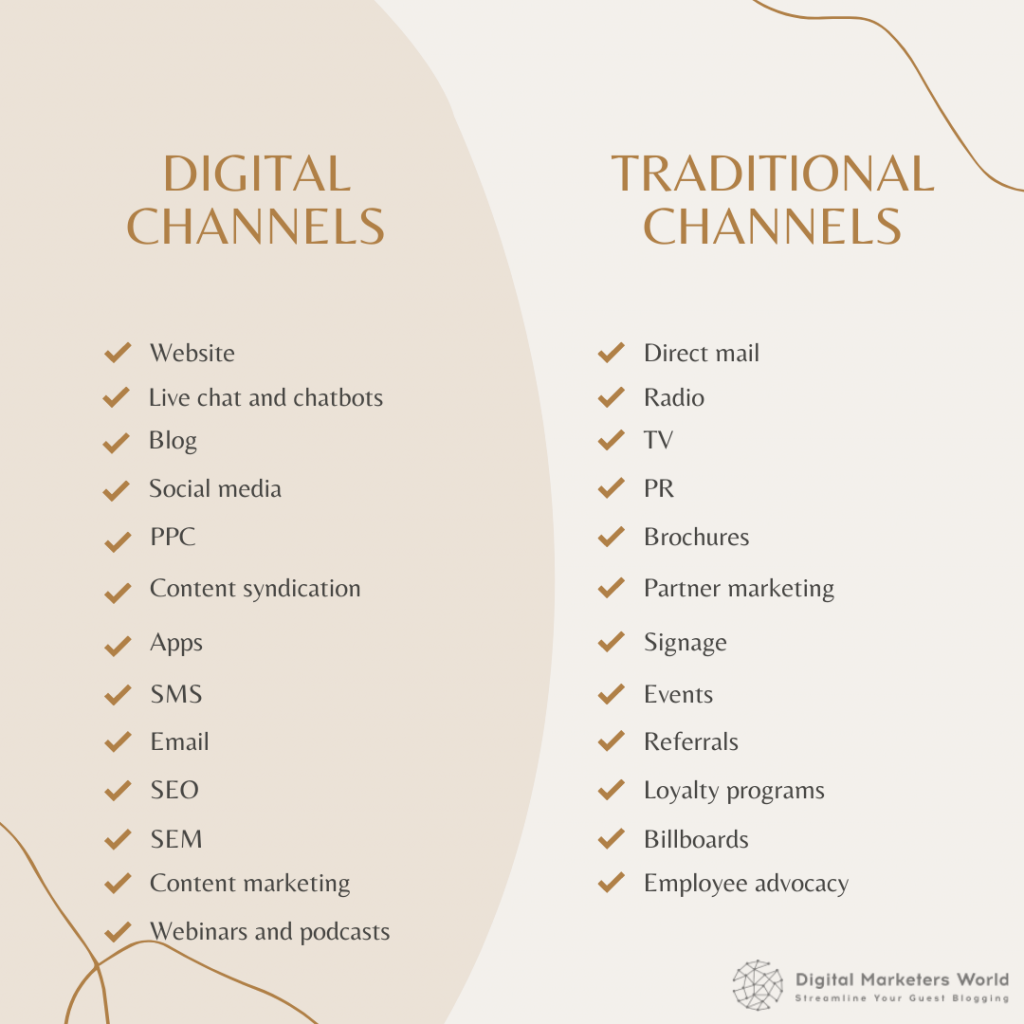
It’s worth mentioning that, although we added content marketing to the Digital category, its nature is more diverse. After all, direct mail also involves creating content, and so does telemarketing and signage. We’re just talking about different content types.
Now, how do you choose the right demand generation channel?
Your decision will depend on how each medium performs according to these two factors:
- Lead generation – how well a particular channel delivers new prospects.
- Lead nurturing and pipeline acceleration – the ability of each channel to qualify the prospects and convert them into paying customers.
The next factor involves sales funnel stages, of which there are three:
- Top of the funnel (TOFU) – educating leads and building awareness.
- Middle of the funnel (MOFU) – proving that your product/service is the best fit.
- Bottom of the funnel (BOFU) – pushing the prospect to the purchase decision.
Naturally, each of these stages will require different demand gen channels, and the content for each of them will differ a lot. For instance, the TOFU stage usually involves brand-specific introductory information (can include infographics and landing pages, while MOFU might offer in-depth case studies, white papers, podcasts, and other content focused on building a relationship.
What else should you keep in mind?
Your goals, market demand and budget, of course. If you’re running a startup and just beginning to roll out your SaaS marketing strategy, traditional channels might not be the best option since they are more expensive (they bring fast results, though).
Apart from that, keep an eye on what your competitors are doing. Their strengths and weaknesses can give you an idea of what your demand marketing strategy should look like. And, by all means, invest in a high-quality content marketing strategy from the beginning.
Step #2: Choose the exact activities for each of these channels
Let’s talk about the strategies and tactics you can use for each demand gen medium we’ve discussed in the previous section.
There is not much difference when it comes to choosing these strategies – consider all the factors we’ve listed a bit earlier (performance, sales funnel stages, goals, and budget). So, let’s take a look at a few examples for each channel category to give you a bit of inspiration.
We’ll start with digital media. Here, you will find strategies for each sales cycle stage. For instance, you can use banner ads to introduce your brand to potential buyers and then add case studies to your website to help them learn more about your solution.
Moz is an excellent example of these two strategies in action. Here’s its banner ad we saw while using an online dictionary website:

When you click on this ad, it redirects you to the free trial page, where you can see the names of the brands using Moz, the features its solution includes, a short demo video, and a customer testimonial.
However, if it’s not enough for you to make the purchase decision, you can dive deeper into Moz’s website and uncover numerous case studies proving that the brand’s product delivers positive results:
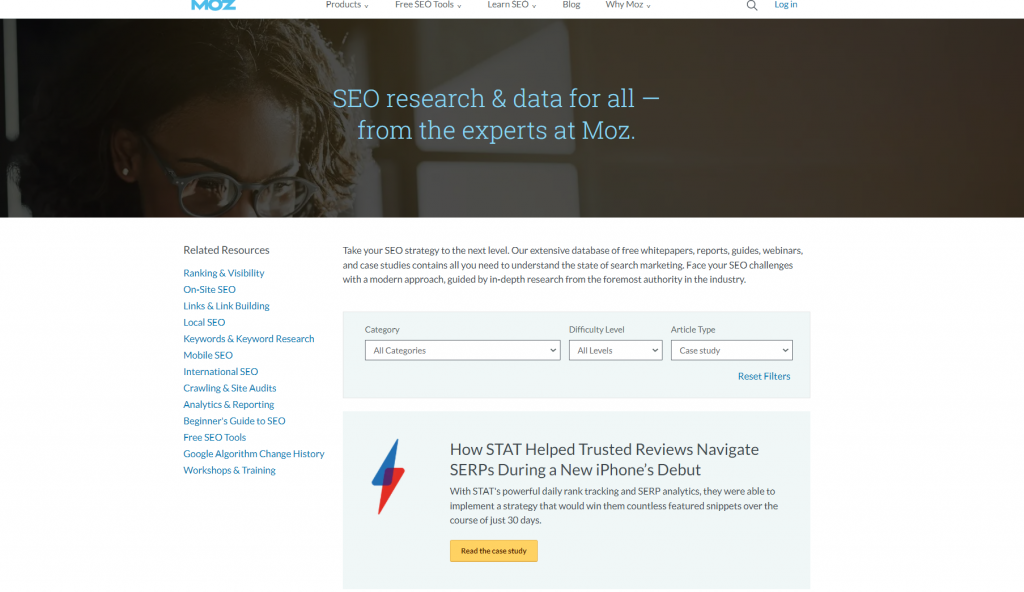
All case studies are free and do not require a subscription.
Finally, if you feel like you know enough about Moz as a brand but still have a few questions, you can jump to the FAQ section, where the Moz community handles all the inquiries from regular clients and new customers:
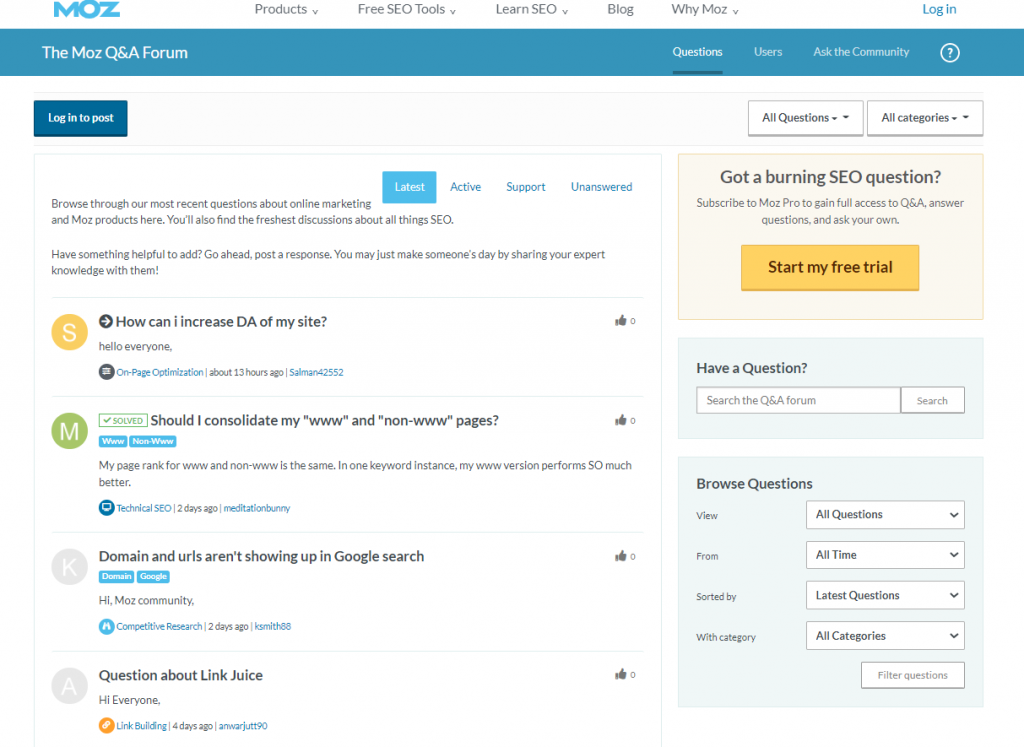
As a result, Moz covers all three marketing funnel stages with these three demand generation strategies. Of course, they are not the only ones – Moz also has an entire B2B marketing process including a blog, social media, a YouTube channel and employs a bunch of other activities to attract prospects and build meaningful relationships with them.
What about traditional channels?
One of the most common tactics among B2B brands is representing their products during an event. For example, Ahrefs took part in an SEO conference back in 2018:
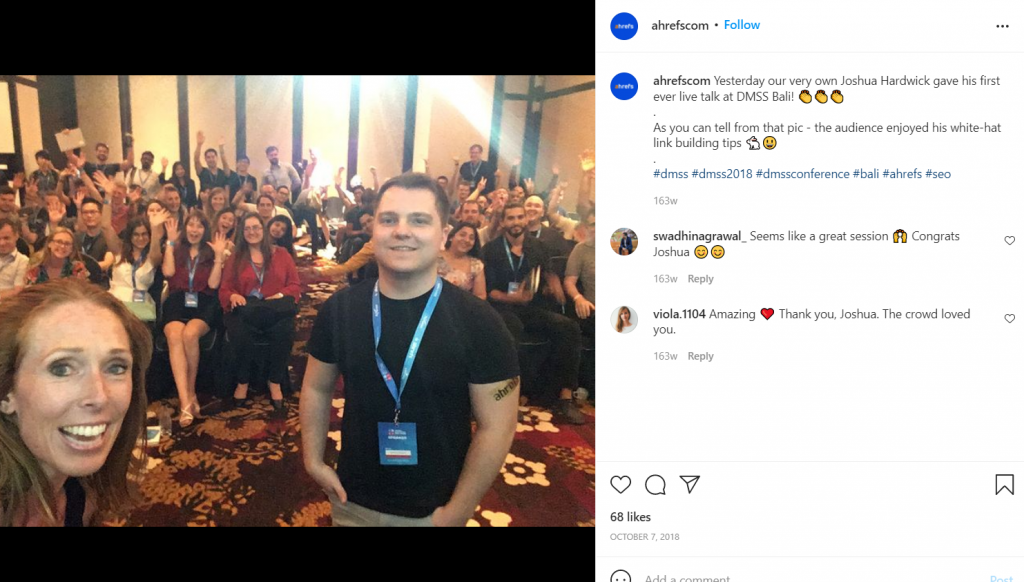
You can involve events both at the TOFU and MOFU stage to first introduce leads to your product and then give them a chance to ask more questions, which helps your prospects convert faster.
Step #3: Define your north star metric and your Key Performance Indicators (KPIs) for each channel
The ‘North Star’ metric (NSM) is the indicator that helps evaluate the success of your demand gen strategy and track it along the way.
Ideally, the ‘North Star’ metric should:
- Measure progress
- Show customer value
- Lead to revenue
Your focus should lie on all three factors together. Concentrating on revenue alone won’t lead anywhere since demand generation is also about building a long-lasting relationship with customers.
The examples of demand generation NSMs include:
- Number of marketing leads (MQLs)
- Number of sales-qualified leads (SQLs)
- Cost per acquisition (CPA)
- Customer Lifetime Value (CLV)
- Monthly recurring revenue
- Average deal size
- Close rate per channel
You can read about most of these metrics in our B2B KPIs article.
Apart from all the indicators mentioned above, your B2B demand generation program should focus on conversion rates since they show the factual state of your sales funnel. If this indicator is too low, it’s time for conversion rate optimization – you need to find the gaps in your strategy and fix them.
Now, how do you pick the right NSM for each of the channels?
It would help to answer the following questions:
- When does a prospect reach the desired end result?
- Does it apply to all prospects?
- Can we measure this moment?
- How often should you measure it (daily, monthly, quarterly, yearly)?
- Which factors can impact the moment of conversion?
- Is this metric connected to business growth?
- Could this metric change over time?
In the end, you get a metric that:
- Equals to your customer’s success moments
- Shows value to the customer
- Is measurable
- Is time-bound
- Is within your control
- Is growing with a specific frequency
- Reflects growth
Note: each of the strategies and channels should have its own NSMs. This way, it will be easier for you to spot a malfunctioning tactic, fix it or swap it for a different one.
Step #4: Iterate based on the results and focus on your best-performing channels and activities
Finally, you can’t succeed at demand generation if you don’t continuously track your progress. Otherwise, your strategy might start leaking money.
For most of the tactics, you can use inbound marketing tools, which also work for B2C marketing automation. These tools can help you:
- Scale your demand gen processes
- Improve customer experience
- Track and measure intent data
- Drive up the conversion rates
- Track your efforts in real-time
- Get insightful reports
Do not underestimate data tracking when it comes to demand generation. Building a successful strategy requires a significant budget, so the last thing you want is to lose money. Other reasons for an underperforming demand gen strategy include:
- Not qualifying your leads
- Not segmenting the prospects
- Poor lead scoring tactics
- Not providing free resources
- Overlooking customer experience
Having specific KPIs and metrics figured out really helps build a proper strategy from the bottom up. However, you can’t be too careful – make sure to test your efforts religiously, and the results will pleasantly surprise you.
Now Over to You
Demand generation seems easy in theory, but in practice, it’s no joke. It will most likely take you some time to figure out what works for you. However, you still can’t enter the demand gen zone unprepared.
Here’s a quick overview of what you need to do:
- Choose your channels.
- Find activities for each of the channels.
- Define the metric for each activity and channel.
- Track your results on an ongoing basis.
Also, it wouldn’t hurt to see what your rivals are up to and how they execute demand generation. What works for them might also be helpful in your case, but make sure your efforts align with what your target audience expects of you.
Want to learn more about lead generation and other marketing strategies? Go to our blog for more insightful tips!
Frequently Asked Questions (FAQs)
Still got some questions regarding demand generation? We’ll happily answer them.
Q1. What are some metrics of success for demand generation?
Some metrics of success for demand generation include:
- Number of marketing-qualified leads (MQLs) per channel
- Number of sales-qualified leads (SQLs) per channel
- Close rate per channel
- Best acquisition channel
- Conversion rate per channel
However, choose the right metric based on your goals.
Q2. What are the top three mistakes in demand generation?
These are the most common mistakes:
- No proper lead segmentation
- No lead scoring and qualification process
- Not enough relevant content at each of the sales funnel stages
- Absence of a unified message
Q3. What is the difference between inbound marketing and demand generation?
The difference is easy to spot: demand generation is more sales-centric, while inbound marketing is focused on promotions and branding.

Mariia is a content strategist and editor at Digital Marketer’s World. She is passionate about educating others on all things marketing and believes in the power of the written word.
